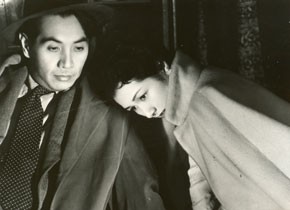Mikio Naruse
February 9 to March 8, 2007
Even though Mikio Naruse (1905-1969) has been accepted as one of the giants of cinema for some time, his oeuvre is still treated with a certain amount of reserve. Critics show their enthusiasm, but very few wax euphoric in the same way as they do about Ozu and Mizoguchi – the contemporaries to whom Naruse is often compared.
The fact that his films are very infrequently shown, is certainly one of the reasons: Naruse Retrospectives in this part of the world are indeed a rare treasure. For the first time since the early 1980s, the Film Museum is now showing a comprehensive selection of his works.
Like Ozu (with whom he started out in the Shôchiku Studio in the early 1920s), Naruse is a master of the shomingeki, the melodrama of "ordinary folk". As in Mizoguchi's films, his principal works relate stories about the sad or tragic fate of women.
These extend from Kimi to wakarete (Apart from You, 1933) to Meshi (Repast, 1951) and Ukigumo (Floating Clouds, 1955) and to Midaregumo (Scattered Clouds, 1967), to name just four of the many peaks in the Naruse Range. Unlike his two colleagues, however, Naruse never attempted to position himself as a great artist. He saw himself as a hired artisan – an outstanding master of a certain type of work who was also able to realize completely different types of assignment in a highly individual way, whether they were beguiling comedies or compact historical dramas.
He continued to create made-to-measure films right up to the end of his career. Originally, Naruse had ended up in film-making only because he urgently needed a job. After the death of his father, every member of the family was obliged to find work; Naruse had just turned 15. He remained a child of the lower middle class, teetering on the brink of poverty. Later on, when he had money, he refused to abandon these roots.
Naruse did not cultivate any obvious trademarks (as did Mizoguchi, for example, with his long takes). His highly complex aesthetic system adjusts to the chosen stories as easily as water. His films flow: shot after shot there is a new perspective, the camera angle changes, closer in or farther out; confrontations – shot and counter-shot – are rare. Naruse meticulously outlines the gradual shifts of strength and power in the relationships between persons, achieving a distinct rhythm in which important and minor events assume the same significance.
The viewer can detach himself from one strand of the plot and fall in with the flow, and it is not until the end of the film that one realizes what it was actually about. It is only the ending, or death, which creates meaning, makes visible the structures of a life and allows them to be narrated.
Ultimately, Naruse is a truly secular filmmaker whose works are not about serenity or the acceptance of life as something that is by essence full of suffering. His films are about problems which are certainly closer to the majority of the public than the "soul".
They are concerned with answers to concrete questions: "How much does the rice cost?"; "How am I going to pay the rent? Do I have one last kimono which I can pawn or sell?"; "Do I have to take my son out of school and send him to work to help feed the family? Or would we be better off if I gave him up for adoption so he can get an education?"; "Wouldn't it make more sense for me to be a kept woman in order to get ahead?"; "Should I get a divorce, and why did I ever marry in the first place?"; "Why was I ever born?"
In Naruse's films, people talk about money as one seldom does in real life (but would often like to); they talk about life as a piece of merchandise; they treat others the same way they treat themselves; and they desperately wish things were different. Naruse talks about how most people are: poor and needy, without shame in their neediness, and asocial in both good and bad terms.
In Inazuma (Lightning, 1952), a woman says that only the dead can be happy, to which another woman rejoins that one would have to die to find out whether she's right. Mikio Naruse directed 89 films; 32 of these can be seen in the show. The films that he created taste like life. There are moments where one feels he was the greatest filmmaker of all time.
The Retrospective takes place with the generous support of the Japan Foundation and the National Film Center in Tokyo.
